Principality of Theodoro
The Principality of Theodoro (Greek: Πριγκιπάτο της Θεοδωρούς), also known as Gothia (Greek: Γοτθία) or the Principality of Theodoro-Mangup,[2] was a Greek-speaking[3] principality in the south-west of Crimea. It represented both the final rump-state of the Byzantine Empire and the last territorial vestige of the Crimean Goths until its conquest by the Ottoman Turks in 1475. Its capital was Doros, also sometimes called Theodoro and now known as Mangup. The state was closely allied with the Empire of Trebizond.
Lordship of the city of Theodoro and the Maritime Region Αὐθεντία πόλεως Θεοδωροῦς καὶ παραθαλασσίας | |||||||||
|---|---|---|---|---|---|---|---|---|---|
| early 14th century–1475 | |||||||||
 Coat of arms
| |||||||||
Crimea in the middle of the 15th century.
Theodoro shown in green | |||||||||
| Status | Principality | ||||||||
| Capital | Mangup (Doros, Theodoro) | ||||||||
| Common languages | Greek (official), also Crimean Gothic, Kipchak and others | ||||||||
| Religion | Orthodox Christianity | ||||||||
| Government | Monarchy | ||||||||
| Prince | |||||||||
• 1475 | Alexander of Theodoro | ||||||||
| Historical era | Late Middle Ages | ||||||||
• First mention of the principality | early 14th century | ||||||||
• Ottoman conquest | 1475 | ||||||||
| |||||||||
| Today part of | Disputed between Russia and Ukraine[1] | ||||||||
History
In the late 12th century the Crimean peninsula had seceded from the Byzantine Empire, but soon after the sack of Constantinople in 1204 parts of it were included in the Trebizondian Gazarian Perateia.[4] This dependence was never very strong and was eventually replaced by the invading Mongols,[5] who in 1238 poured into the peninsula, occupied its east and enforced a tribute on the western half, including Gothia.[6] Apart of said tribute their influence was limited, leaving administrative matters in native hands.[7]
The Principality of Gothia is first mentioned in the early 14th century, with the earliest date offered by the post-Byzantine historian Theodore Spandounes, who records the existence of a "Prince of Gothia" in the reign of Andronikos III Palaiologos (1328–1341). Further references occur over the course of the 14th century, with several scholars identifying the "Dmitry", one of the three Tatar princes in the Battle of Blue Waters (c. 1362/3), with a Prince of Gothia. The name, in this case, may possibly be the baptismal name of a Tatar lord of Mangup, named Khuitani (see below).[8] The name "Theodoro" (in the corrupted form Θεοδωραω) appears for the first time in a Greek inscription also dated to c. 1361/2, and then again as "Theodoro Mangop" in a Genoese document of 1374.[9] It was suggested by A. Mercati that the form is a corruption of the Greek plural "Theodoroi", "the Theodores", meaning Saints Theodore Stratelates and Theodore Tiro, but N. Bănescu proposed the alternative explanation that it resulted from the definitive Greek name τὸ Δόρος (to Doros) or τὸ Δόρυ (to Dory),[10] after the early medieval name of the region.[11] Whatever its provenance, the name stuck: by the 1420s the official titelature of the prince read "Lord of the city of Theodoro and the Maritime Region" (αὐθέντης πόλεως Θεοδωροῦς καὶ παραθαλασσίας),[12] while colloquially it was called "Theodoritsi" (Θεοδωρίτσι, "little Theodoro") by its inhabitants.[13]
In 1395 the warlord Tamerlane invaded the Crimean peninsula, destroying several towns including Gothia's capital Theodoro.[14] After his death in 1404 Gothia grew to become one of the most significant powers of the Black Sea, profiting from a period of Genoese instability and its neglect of its Black Sea colonies, but also the rise of the Crimean Khanate. In 1432 Gothia sided with Venice against Genoa due to the latter's promise to grant Gothia access to the sea.[15]
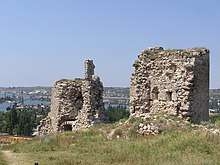
The principality had peaceful relations with the Golden Horde to its north, paying an annual tribute as vassals, but was in constant strife with Genoese Gazaria colonies to the south over access to the coasts and the trade that went through the Crimean harbours. A narrow strip of the coastal land from Yamboli (Balaklava) in the west to Aluston (Alushta) in the east initially part of the principality soon fell under Genoese control. Local Greeks called this region Parathalassia (Greek: Παραθαλασσια, "sea shore"), while under Genoese rule it was known as Captainship of Gothia. After they had lost harbours on the southern coast Theodorites built a new port called Avlita at the mouth of the Chernaya River and fortified it with the fortress of Kalamita (modern Inkerman).
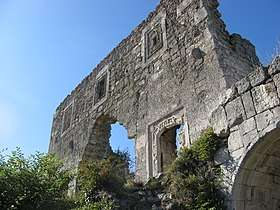
On 6 June 1475, the Ottoman commander Gedik Ahmet Pasha conquered Caffa and at the end of the year, after six months of besieging Mangup, the city fell to the assailants. While much of the rest of Crimea remained part of the Crimean Khanate, now an Ottoman vassal, the former lands of Theodoro and southern Crimea were administered directly by the Sublime Porte.
Princes of Theodoro
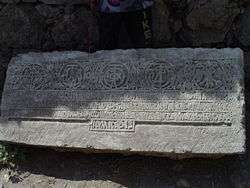
The historian Alexander Vasiliev identifies the first prince as Demetrios, attested at the Battle of Blue Waters in c. 1362/3. According to Vasiliev, he is possibly to be identified with the hekatontarches Khuitani, who erected the stone inscription mentioning the name "Theodoro" on the walls of Mangup at about the same time.[16]
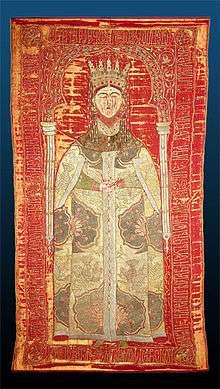
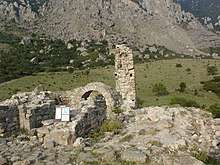
The princes following after Demetrios are known solely through Russian sources. The prince Stephen ("Stepan Vasilyevich Khovra"), emigrated to Moscow in 1391 or 1402 along with his son Gregory. His patronymic implies the existence of a father named Basil, who possibly preceded him as prince (and was in turn possibly Demetrios' son). Stephen and Gregory became monks, and Gregory later founded the Simonov Monastery in Moscow. The Russian noble families of Khovrin and Golovin claimed descent from them.[17][18] In Gothia, Stephen was succeeded by another son, Alexios I, who ruled until his death in 1444–45 or 1447. Alexios' heir was his eldest son John, who was married to Maria Asanina, a lady connected to the Byzantine imperial dynasty of the Palaiologoi and the noble lines of Asanes and Tzamplakon. The couple had a son, also named Alexios, who died young c. 1446/7, probably at Trebizond. His epitaph, titled "To the Prince's son" (τῷ Αὐθεντοπούλῳ), was composed by John Eugenikos and offers unique genealogical data on the family.[17][19] John's reign appears to have been very short, or he may indeed not have reigned at all – A. Vasiliev speculates that he left Gothia for Trebizond as soon as Alexios I died[20] – so another son of Alexios I, Olubei, succeeded as prince in c. 1447 and ruled until c. 1458.[21] A daughter of Alexios I, Maria of Gothia, became in 1426 the first wife of the last Trapezuntine emperor, David.[17][22]
Olubei is no longer mentioned after c. 1458, and no princes are known by name for some while; Genoese documents only mention "the lord of Theodoro and his brothers" (dominus Tedori et fratres ejus).[23] In 1465, prince Isaac is mentioned, probably Olubei's son and hence possibly reigning already since c. 1458.[24] In the face of the mounting Ottoman danger, he engaged in a rapprochement with the Genoese at Caffa and wed his sister Maria Asanina Palaiologina to Stephen the Great, ruler of Moldavia.[25] His increasingly pro-Ottoman stance in later years, however, led to his overthrow by his brother Alexander, with Stephen the Great's backing.[26] This came too late to save Theodoro: in December 1475, after conquering the other Christian strongholds along the Crimean coast, the Ottomans captured the city after a three-month siege. Alexander and his family were taken captive to Constantinople, where the prince was beheaded. His son was forcibly converted to Islam, and his wife and daughters became part of the Sultan's harem.[27]
Culture
_horseman.jpeg)
Gothia's population was a mixture of Greeks, Crimean Goths, Alans, Bulgars, Cumans, Kipchaks and other ethnic groups, most of whom were adherents to Orthodox Christianity and Hellenized. The principality's official language was Greek.
Various cultural influences can be traced in Gothia: its architecture and Christian wall paintings were essentially Byzantine, although some of its fortresses also display a local as well as Genoese character. Inscribed marble slabs found in the region were decorated with a mixture of Byzantine, Italian and Tatar decorative elements.[28]
References
- This place is located on the Crimean peninsula, most of which is the subject of a territorial dispute between Russia and Ukraine. According to the political division of Russia, there are federal subjects of the Russian Federation (the Republic of Crimea and the federal city of Sevastopol) located on the peninsula. According to the administrative-territorial division of Ukraine, there are the Ukrainian divisions (the Autonomous Republic of Crimea and the city with special status of Sevastopol) located on the peninsula.
- Kołodziejczyk 2011, p. 21.
- Khvalkov, Evgeny (August 2017). The Colonies of Genoa in the Black Sea Region: Evolution and Transformation. Routledge. ISBN 978-1138081604.
- Vasiliev 1936, p. 159.
- Vasiliev 1936, p. 182.
- Vasiliev 1936, pp. 163-164.
- Vasiliev 1936, pp. 182-183.
- Vasiliev (1936), pp. 183–186
- Vasiliev (1936), pp. 185–187
- Vasiliev (1936), p. 191
- Pritsak (1991), pp. 654–655
- Vasiliev (1936), p. 215
- Vasiliev (1936), p. 218
- Albrecht 2013, p. 41.
- Albrecht 2013, p. 44.
- Vasiliev (1936), pp. 183–186, 198
- Bryer (1970), p. 184
- Vasiliev (1936), pp. 198–200
- Vasiliev (1936), pp. 194–198, 222
- Vasiliev (1936), pp. 222–223
- Vasiliev (1936), pp. 222, 224ff., 235
- Vasiliev (1936), p. 214
- Vasiliev (1936), p. 235
- Vasiliev (1936), pp. 236–237
- Vasiliev (1936), pp. 238–239
- Vasiliev (1936), p. 244
- Vasiliev (1936), pp. 249–265
- Karpov 1996, p. 675.
Sources
- Albrecht, Stefan (2013). "Ein Spielball der Mächte: Die Krim im Schwarzmeerraum (VI.-XV. Jahrhundert)". In Stefan Albrecht; Michael Herdick (eds.). Die Höhensiedlungen im Bergland der Krim. Umwelt, Kulturaustausch und Transformation am Nordrand des Byzantischen Reiches (in German). Schnell & Steiner. ISBN 978-3-7954-2768-9.
- Beyer, Hans-Veit (2001). История крымских готов как интерпретация Сказания Матфея о городе Феодоро [History of the Crimean Goths as an interpretation of the Tale of Matthew on the city of Theodoro] (in Russian). Yekaterinburg: Ural University Press. ISBN 5-7525-0928-9.
- Bryer, Anthony M. (1970). "A Byzantine Family: The Gabrades, c. 979 – c. 1653". University of Birmingham Historical Journal. Birmingham. XII: 164–187.
- Pritsak, Omeljan (1991). "Dory". In Kazhdan, Alexander (ed.). The Oxford Dictionary of Byzantium. Oxford University Press. pp. 654–655. ISBN 978-0-19-504652-6.
- Vasiliev, Alexander A. (1936). The Goths in the Crimea (PDF). Cambridge, Massachusetts: The Mediaeval Academy of America.
- Vasilyev, A. V.; Avtushenko, M. N. (2006). Загадка княжества Феодоро [The riddle of the principality of Theodoro] (in Russian). Sevastopol: Bibleks. ISBN 9789668231643.
- Fadeyeva, Tatiana M.; Shaposhnikov, Aleksandr K. (2005). Княжество Феодоро и его князья [The Principality of Theodoro and its princes] (in Russian). Simferopol: Biznes-Inform. ISBN 9789666480616.
- Karpov, Sergei P. (1996). "The Crimeans". In Sigfried J. de Laet (ed.). History of Humanity: From the seventh to the sixteenth century. Routledge. pp. 672–676.
- Kołodziejczyk, Dariusz (2011). The Crimean Khanate and Poland-Lithuania: International Diplomacy on the European Periphery (15th-18th Century). A Study of Peace Treaties Followed by Annotated Documents. Leiden: Brill. ISBN 9789004191907.
External links
- Brief history of Theodoro Principality (Mangup) ENG
- ISOPE. Ancient Inscriptions of the Northern Black Sea (also features inscriptions from Theodoro)
Further reading
Beyer, Hans-Veit (2003). "Die Erzählung des Matthaios von der Stadt Theodoro". Byzantinische Zeitschrift (in German). 96: 25–56.